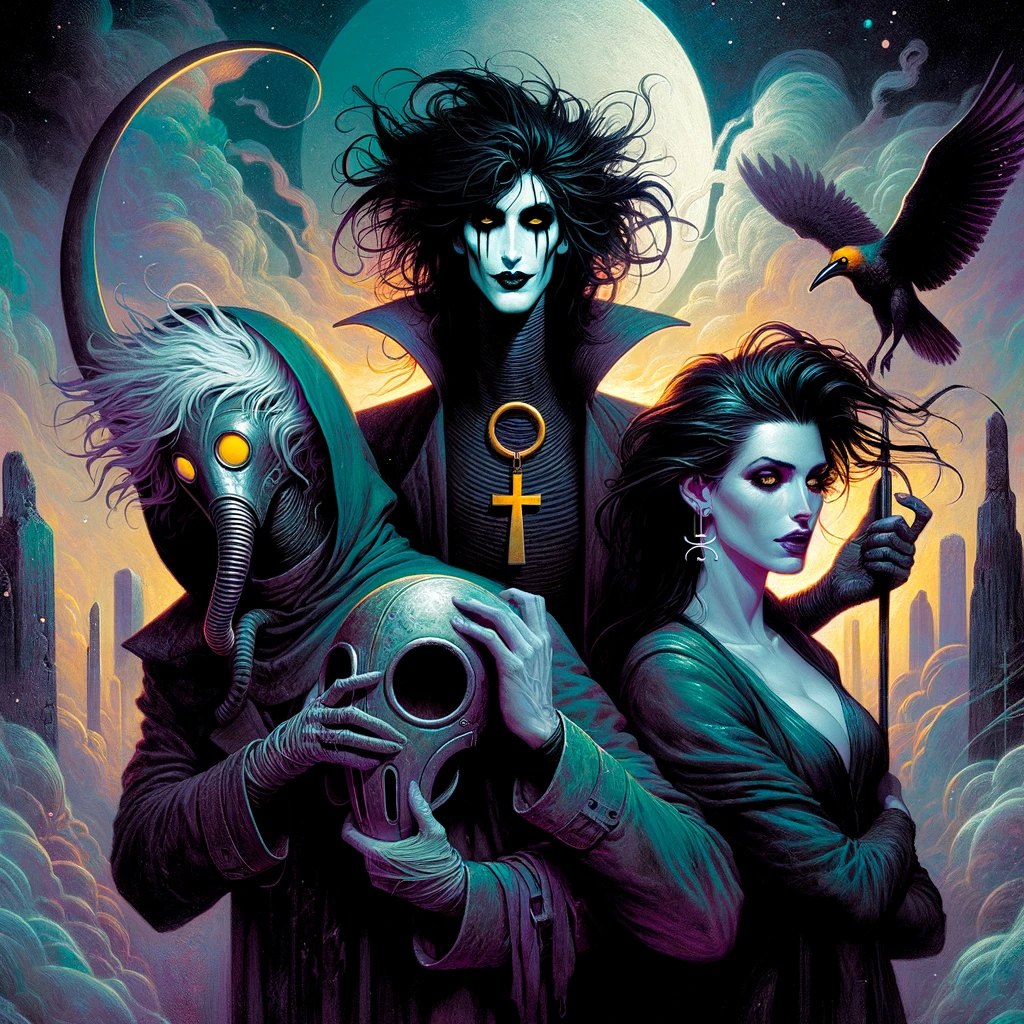
Here is the dark fantasy and horror-themed artwork inspired by the Sandman universe, featuring the characters Dream, Death, and Desire. The mystical and eerie atmosphere of the scene reflects the unique attributes of each character.
“Sandman,” often hailed as a masterpiece in the realm of graphic novels, is a profound exploration of dark fantasy and horror. Created by Neil Gaiman, this series stands out for its intricate storytelling and profound themes.
The story revolves around Dream, also known as Morpheus, one of the seven Endless. Dream is a complex character, embodying both the harshness and vulnerability of the dream realm he governs. His interactions with his siblings, especially Death and Desire, add layers to the narrative, each character being a personification of universal concepts.
Death, depicted as a goth-like, approachable figure, is particularly memorable. She brings a sense of warmth and depth to the concept of death, challenging traditional perceptions. Desire, on the other hand, is an embodiment of seduction and longing, depicted as androgynous and manipulative, adding a layer of intrigue and complexity to the story.
The series is lauded for its rich, literary narrative, blending mythology, history, and horror in a tapestry of stories that are both individual and interconnected. Gaiman’s writing is eloquent and thoughtful, often delving into philosophical questions about life, death, and what it means to be human.
The artwork throughout the series is a key element, with a range of artists bringing their unique styles to the different story arcs. The visuals are often haunting and ethereal, perfectly complementing the mood of the narrative.
In essence, “Sandman” is not just a comic book; it’s a piece of art that transcends the medium. It’s a deep, emotionally resonant journey that stays with the reader long after the last page is turned. Its exploration of themes like dream, death, and desire is both profound and enchanting, making it a must-read for fans of the genre.
“Sandman” stands out not only for its central characters but also for its expansive and diverse cast, ranging from mythical gods to historical figures, and from ordinary humans to fantastical creatures. This diversity allows the series to explore a multitude of stories and settings, from ancient mythologies to contemporary tales, adding a richness and depth that is rare in graphic novels.
The narrative structure of “Sandman” is another of its strengths. Gaiman masterfully weaves a complex tapestry of stories that can stand alone yet are intricately connected to the larger narrative. This episodic yet cohesive structure makes the series continually fresh and engaging. Each volume introduces new themes and characters, yet it always feels grounded in the universe Gaiman has created.
The series is also notable for its psychological depth. Through Dream and his siblings, Gaiman explores the complexities of human emotions and experiences. The characters are not just embodiments of abstract concepts; they have personalities, weaknesses, and conflicts, which make them relatable and compelling.
Moreover, “Sandman” is celebrated for its influence on the graphic novel genre. It broke new ground in terms of what could be achieved in a comic book format, both in storytelling and in art. It challenged and expanded the boundaries of the medium, paving the way for more sophisticated and ambitious works in the graphic novel genre.
“Sandman” is a seminal work in the world of graphic novels. Its blend of dark fantasy, horror, and rich storytelling creates a unique and unforgettable experience. It’s a series that appeals not just to comic book fans but to anyone who appreciates deeply layered storytelling and art. Neil Gaiman’s “Sandman” is, without a doubt, a landmark achievement in the graphic novel form and a high point in modern storytelling.
FAQ: Sandman (Updated 2024)
Q: What is ‘Sandman’ about? A: “Sandman” is a graphic novel series written by Neil Gaiman. It revolves around Dream (also known as Morpheus), one of the seven Endless. The story explores themes of dream, reality, life, and death, combining elements of dark fantasy, horror, and mythology.
Q: Who are the main characters in ‘Sandman’? A: The main character is Dream, the personification of dreams. Other central figures include his siblings, particularly Death, who is warm and approachable, and Desire, who is androgynous and manipulative. The series features a vast array of other characters from various mythologies and historical periods.
Q: How many volumes are in the ‘Sandman’ series? A: As of 2024, the original “Sandman” series consists of 10 volumes. However, there have been various spin-offs and additional stories set in the Sandman universe released over the years.
Q: Has ‘Sandman’ been adapted into other media? A: Yes, “Sandman” has been adapted into various forms, including an acclaimed TV series, audiobooks, and possibly more recent media adaptations as of 2024. These adaptations have brought the story to a wider audience and have been generally well-received for staying true to the source material.
Q: Is ‘Sandman’ suitable for young readers? A: “Sandman” is generally recommended for mature readers due to its complex themes, dark content, and occasional graphic imagery. It’s best suited for adults and older teenagers.
Q: What makes ‘Sandman’ stand out in the graphic novel genre? A: “Sandman” is renowned for its rich storytelling, deep character development, and the blending of various mythologies and historical narratives. Its impact on the graphic novel genre is significant, having pushed the boundaries of what can be achieved in comic book storytelling.
Q: Are there any recent ‘Sandman’ publications or events as of 2024? A: As of 2024, there may have been new spin-offs, anniversary editions, or special events related to “Sandman.” It’s best to check the latest news or official Neil Gaiman channels for up-to-date information.
Q: Where can I buy ‘Sandman’ graphic novels? A: “Sandman” graphic novels are available at most bookstores, comic book shops, and online retailers. Digital versions can also be purchased through various e-book platforms.
Q: Are there any fan communities or events for ‘Sandman’? A: Yes, there are active fan communities online, including forums, social media groups, and fan websites. Additionally, “Sandman” often features in comic book conventions and literary events.
This FAQ provides a general overview, but for the most current information, especially regarding recent publications or events, it’s advisable to check the latest sources.
The Everlasting Dream of Sandman
As we look towards the future, “Sandman” remains an enduring testament to the power of storytelling in graphic novels. Its influence stretches far beyond its pages, continuing to inspire new generations of writers, artists, and creators. The rich tapestry of its narrative, the depth of its characters, and its exploration of universal themes ensure that “Sandman” retains its relevance and appeal.
The future may hold further adaptations and explorations in the Sandman universe. With advancements in technology and storytelling mediums, there’s potential for even more immersive and innovative ways to experience the world of Dream, Death, and Desire. Perhaps virtual reality or interactive narratives could offer new paths into the Endless realms. Whatever the future holds, one thing is certain: the dream that Neil Gaiman created will continue to captivate, provoke thought, and inspire awe.
As we continue to journey through the ever-expanding universe of “Sandman,” we invite your thoughts and comments. What has been your experience with “Sandman”? Which aspects resonate with you the most? Are there any future adaptations or explorations you’re particularly excited about or wish to see? Share your insights and be a part of the ongoing dialogue surrounding this iconic and timeless series. Your perspective adds to the rich tapestry of its legacy. Let’s dream on, together.

